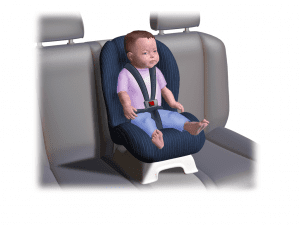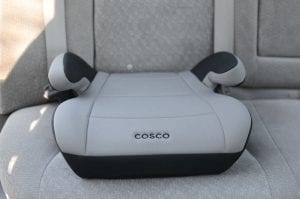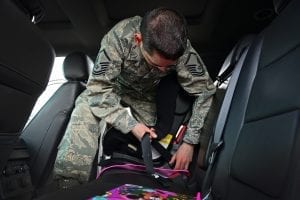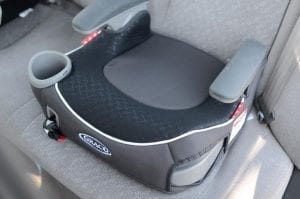If you’re a new parent or a parent with a toddler-aged child and not quite sure where to begin concerning booster seat safety and use, you’ve come to the right place. We’ll share with you the best seats on the market.

This article provides the necessary information on booster seat laws and regulations for drivers and passengers in the US.
Keep reading to learn more about booster seat safety and requirements.
Car Seat And Seat Belt Parameters
These seats are made with either a high-back for additional head rest and head and neck support, which is safe to use when the vehicle seat for your child comes at least up to your child’s ears to assure adequate support when they are buckled, even when kids try leaning forward, and if an unexpected accident should occur. This kind of support is crucial to keep older children and kids safe. A booster makes sure that the lap belt fit is correct and that the shoulder belt lies across the chest, not the neck, providing the best protection for your child.
These units are smaller lightweight versions of full-sized car seats with the leading safety equipment and latch system being attached to the cushion that boosts the child up so they can be positioned safely in passenger vehicles. It is essential to ensure that the harness car seat is appropriately adjusted to fit snugly, which is especially important as your child is ready to transition from a car seat with a harness to a booster seat.
Backless booster seat parameters include meeting height and weight limits specified by the car seat manufacturer, ensuring the seat belt fits properly with a lap and shoulder belt, and following guidelines outlined in the vehicle owner’s manual, especially after transitioning your child to a booster. Often, most kids will need boosters until they are big enough for the vehicle seat belt to fit properly, typically when they have reached 4 feet 9 inches in height and are between 8 and 12 years of age. At this stage, they are often referred to as a big kid, but their safety in the car is just as vital as when they were an infant.

Booster Seat Safety
According to AAA’s safe driving laws and the National Highway Transportation Safety Association, seat laws for all drivers and child passengers are as follows:
“Children ages 4 to 8 are required to use boosters unless they are over four feet nine inches tall or weigh over 40 lbs.”
A backless requirement is essential. These general child safety standards apply to all forms of seats. If your children fit within this age and weight range, it is a safe bet that they can sit and ride safely and legally in a standard or booster seat.

Local Seat Laws
Local booster seat laws and regulations in the US vary, but they generally involve guidelines for rear-facing and forward-facing car seats, high-back booster seats, and backless booster seats, as well as the proper use of child restraints based on the child’s age, height, and car seat features. Considerations include not placing a rear-facing car seat in the front seat if there’s an active airbag aiming at the child’s head.
While there are some variations between states in the US on this general child passenger safety guideline, including booster seat laws, the central premise of the safety regulations remains the same: keeping your child in a car seat for as long as possible if your child falls within the instructions.
Visit your local governing authority website to view the laws and statutes related to child passenger safety state laws. You can also visit your state’s Department of Transportation authority or highway safety website for specifics.
Booster Seat Manufacturer Requirements
Along with maintaining the size and weight limits to ride safely in boosters, parents are also asked to use and install both back and booster seats according to the related manufacturer’s instructions. Manufacturer instructions should be included with every booster seat purchase.
If, for some reason, you don’t have a copy of your original instructions, you can download or ask a new instruction booklet by visiting the seat manufacturer’s website.
Booster Requirement Considerations
Features To Consider Regarding Safety
- According to the US Department of Transportation, one of the requirements is to remain safe first. Booster seat use reduces the risk of serious injury to child passengers riding in an automobile by up to 45%. Manufacturers are aware of the strict guidelines for manufacturing and producing quality units that will keep your child safe and parents compliant with national and local laws.
- Essential features to consider regarding safety of boosters include using a rear-facing seat with a harness, securing the car seat correctly, positioning it in the rear-facing position, ensuring the shoulder belt rests properly, following federal safety standards, and transitioning to boosters when the child outgrows the rear-facing seat.

Where Can I Get A Booster Seat?
Booster seats are available to purchase online and in-store at many popular retailers that specialize in selling multiple children’s and baby items, including infant seats. If you’re not sure what kind of inexpensive seat to buy or where to begin to secure a legally compliant booster, you can also contact your local governing authority.
Child Ready Safety Seat Distribution Programs
To prevent crashes, neck injuries, or automobile-related fatalities, many states, governments, and municipalities now offer programs that provide booster seats to families free of charge. The added benefit of using these government-funded programs is that seat use, regulations, and education are also usually provided free of charge.

Check with your state or local governing authority to get more information on child safety distribution programs in your city, state, or county so you don’t need to wonder. The ultimate goal of public and private child safety seat distribution programs is to improve the safety of child passengers and reduce undesirable results by not using proper child safety equipment. Car seats are the most important child safety choices you will make for your child. Do not rush buying just any seat. Take your time, as it will protect your precious child.
No-Back Booster Requirement FAQs
Why Do Booster Seats Expire?
Booster seats expire because safety standards evolve, and using an expired booster seat may not meet current guidelines, jeopardizing the child’s safety in car crashes by not positioning the lap belt properly and ensuring knees are bent over the seat edge when transitioning from rear-facing or forward-facing child restraints to a no-back booster seat.
Can I Switch To A Booster Seat After Outgrowing The Forward-Facing Car Seat?
After outgrowing their forward-facing strapped seat, youngsters can switch to a booster cushion, according to safety experts. When a kid reaches this stage, they are generally 4 years old and weigh between 40 and 65 pounds. It’s crucial to remember that not all kids are the same size or form, so narrow car seats can be essential to ensure a correct fit. Always adhere to the manufacturer’s recommendations for the maximum permitted height and weight of your child’s car seat, and wait as long as possible before switching them to a booster cushion. It is important to check that the seat belt fits correctly before making the switch.
What Height Should I Switch To A Booster Seat?
Switch to a booster seat when the child’s height exceeds the top harness slots of their car seat, their shoulders are below the seat manufacturer’s recommended height, their knees bend comfortably at the edge of the seat, and they can sit so the lap belts fit low on the hips and the shoulder belt crossing the chest, ensuring adherence to strict crash performance standards, especially if lower anchors are unavailable in a minor crash.
How Do You Install A Backless Booster Seat?
Install a no-back booster seat by following backless booster guidelines, ensuring the lap belt rests on the child’s lap in a proper position, and using a booster seat to position the safety belt properly over the collar bone without compromising spinal cord safety, transitioning from rear-facing and forward-facing seats as per child restraint guidelines. The booster seat raises the child so that the shoulder belt crosses the chest correctly and the lap portion of the belt fits low across the child’s thighs.
At What Age Do You Stop Using A 5-Point Harness Strap Restraint?
When a child’s shoulders are higher than the top harness slots of the convertible seats or when their weight exceeds the seat’s weight limit, you usually discontinue utilizing a five-point harness strap restraint. When these restrictions are reached, which normally happens between the ages of 4 and 7, depending on the child’s growth and the particular needs for forward-facing or rear-facing car seats, most convertible seats switch to a belt-positioning booster.
Can My 7-Year-Old Child Use A Booster Seat?
Yes, a 7-year-old child can use a booster seat if they have outgrown their convertible seats but do not yet meet the backless booster criteria to use the adult seat belt alone. The booster ensures that both the lap and shoulder belts fit the child’s body correctly, with the shoulder belt crossing the chest and the lap belt lying flat across the upper thighs, not the stomach.
What Is The Weight Range For Boosters For Kids?
The weight range for most booster seats typically starts around 30 to 40 pounds and can go up to 100 to 120 pounds. It’s important to follow the specific weight limit and height limit guidelines provided by the booster seat manufacturer to ensure the vehicle’s seat belt is positioned safely and correctly.
Should The Car Seat Go Behind The Driver Or The Passenger?
References
AAA Safe Driving Laws: https://drivinglaws.aaa.com
National Highway Traffic Safety Administration: https://nhtsa.gov
Last Updated on May 7, 2023 by Rejie Salazar
DISCLAIMER (IMPORTANT): This information (including all text, images, audio, or other formats on FamilyHype.com) is not intended to be a substitute for informed professional advice, diagnosis, endorsement or treatment. You should not take any action or avoid taking action without consulting a qualified professional. Always seek the advice of your physician or other qualified health provider with any questions about medical conditions. Do not disregard professional medical advice or delay seeking advice or treatment because of something you have read here a FamilyHype.com.